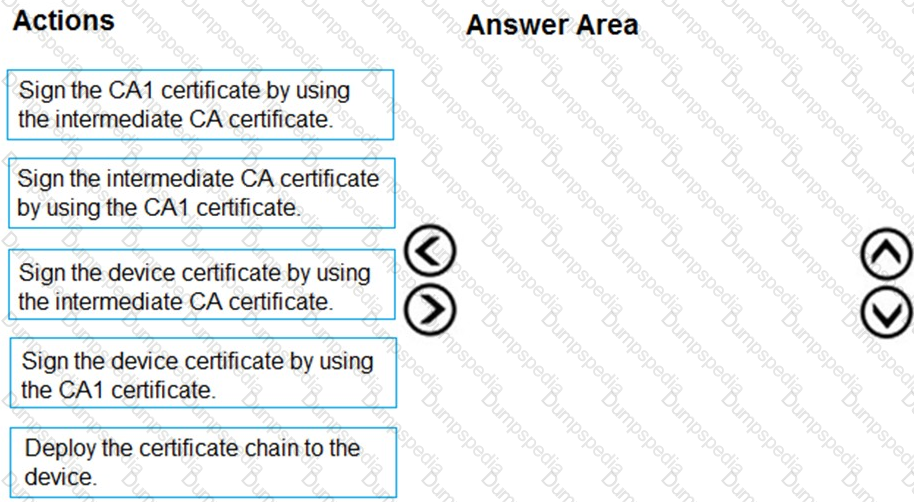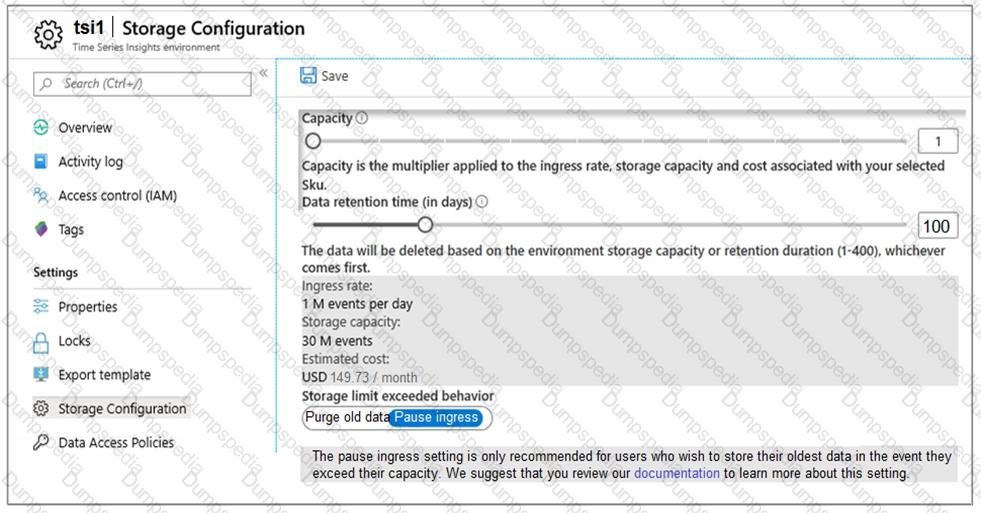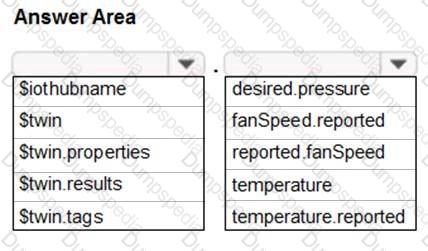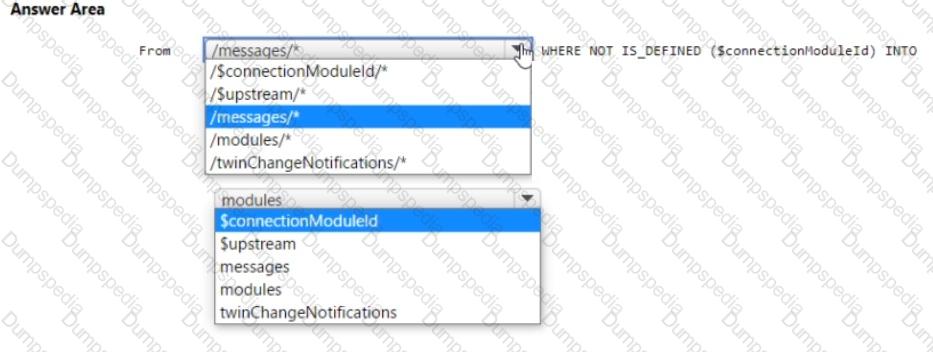You have an Azure IoT hub named Hub1 and a root certification authority (CA) named CA1. Hub1 is configured to use X.509 certificate device authentication.
You and a custom manufacturing partner complete a proof of possession flow.
You plan to deploy IoT devices manufactured by the custom manufacturing partner. Each device will have a certificate generated by an intermediate CA. The devices will authenticate by using device certificates signed by the partner.
You need to ensure that the custom devices can connect successfully to Hub1.
Which three actions should you perform in sequence? To answer, move the appropriate actions from the list of actions to the answer area and arrange them in the correct order.

You use Azure Security Center in an Azure IoT solution.
You need to exclude some security events. The solution must minimize development effort. What should you do?
You have an Azure loT hub named Hub1 and an Azure Service Bus queue named S8Q1.
You create an authorization rule for the Service Bus queue.
You need to configure message routing from Hub1 to SBQ1.
Which three commands should you run in sequence? To answer, move the appropriate commands from the list of commands to the answer area and arrange them in the correct order.

You have an Azure IoT hub named Hub1 and an Azure Time Series Insights environment named tsi1. Tsi1 connects to Hub1. The solution has been operational for 6 months.
Tsi1 is configured as shown in the following exhibit.

Hub1 receives 1 million messages per day. Each message is up to 1 KB and is formatted as JSON.
Hub1 has seven days of retained telemetry.
For each of the following statements, select Yes if the statement is true. Otherwise, select No.
NOTE: Each correct selection is worth one point.

You are developing an Azure IoT Central application.
You add a new custom device template to the application.
You need to add a fixed location value to the device template. The value must be updated by the physical IoT device, read-only to device operators, and not graphed by IoT Central.
What should you add to the device template?
You are troubleshooting an Azure IoT hub.
You discover that some telemetry messages are dropped before they reach downstream processing. You suspect that IoT Hub throttling is the root cause.
Which log in the Diagnostics settings of the IoT hub should you use to capture the throttling error events?
Note: This question is part of a series of questions that present the same scenario. Each question in the series contains a unique solution that might meet the stated goals. Some question sets might have more than one correct solution, while others might not have a correct solution.
After you answer a question in this section, you will NOT be able to return to it. As a result, these questions will not appear in the review screen.
You have a Standard tier Azure IoT hub and a fleet of IoT devices.
The devices connect to the IoT hub by using either Message Queuing Telemetry Transport (MQTT) or Advanced Message Queuing Protocol (AMQP).
You need to send data to the IoT devices and each device must respond. Each device will require three minutes to process the data and respond.
Solution: You use cloud-to-device messages and watch the cloud-to-device feedback endpoint for successful acknowledgement.
Does this meet the goal?
You have an Azure IoT Edge module named SampleModule that runs on a device named Device1.
You make changes to the code of SampleModule by using Microsoft Visual Studio Code.
You need to push the code to the container registry and then deploy the module to Device1.
Which two actions should you perform from Visual Studio Code? Each correct answer presents part of the solution.
NOTE: Each correct selection is worth one point.
You have an Azure subscription that contains a resource group named RG1.
You need to deploy the Device Provisioning Service. The solution must ensure that the Device Provisioning Service can accept new device enrollments.
You create a Device Provisioning Service instance.
Which two actions should you perform next? Each correct answer presents part of the solution.
NOTE: Each correct selection is worth one point.
You have an Azure IoT solution that includes several Azure IoT hubs.
A new alerting feature was recently added to the IoT devices. The feature uses a new device twin reported property named alertCondition.
You need to send alerts to an Azure Service Bus queue named MessageAlerts. The alerts must include
alertCondition and the name of the IoT hub.
Which two actions should you perform? Each Answer presents part of the solution.
NOTE: Each correct selection is worth one point.
Note: This question is part of a series of questions that present the same scenario. Each question in the series contains a unique solution that might meet the stated goals. Some question sets might have more than one correct solution, while others might not have a correct solution.
After you answer a question in this section, you will NOT be able to return to it. As a result, these questions will not appear in the review screen.
You have an Azure IoT solution that includes an Azure IoT hub and an Azure IoT Edge device.
You plan to deploy 10 Bluetooth sensors. The sensors do not support MQTT, AMQP, or HTTPS.
You need to ensure that all the sensors appear in the IoT hub as a single device.
Solution: You configure the sensors to connect directly to the IoT hub.
Does this meet the goal?
You have an Azure IoT hub.
You need to deploy a Device Provisioning Service instance that uses X.509 attestation to support new loT devices.
Which three actions should you perform in sequence in the Azure portal? To answer move the appropriate actions from the list of actions to the answer area and arrange them in the correct order.

How should you complete the GROUP BY clause to meet the Streaming Analytics requirements?
You have an Azure IoT Edge solution.
You plan to deploy an Azure Security Center for IoT security agent. You need to configure the security agent to meet the following requirements:
How should you configure the azureiotsecurity module twin? To answer, drag the appropriate values to the correct locations. Each value may be used once, more than once, or not at all. You may need to drag the split bar between panes or scroll to view content.
NOTE: Each correct selection is worth one point.

You need to use message enrichment to add additional device information to messages sent from the IoT gateway devices when the reported temperature exceeds a critical threshold.
How should you configure the enrich message values? To answer, select the appropriate options in the answer area.
NOTE: Each correct selection is worth one point.

You need to design a module deployment strategy that meets the device requirements. What should you create?
You need to configure a gateway for the child devices. The solution must meet the networking requirements. Which gateway pattern should you use?
You need to configure loT module routing to meet the device requirements.
How should you complete the route? To answer, select the appropriate options in the answer area.
NOTE: Each correct selection is worth one point.

You need to enable telemetry message tracing through the entire IoT solution.
What should you do?
You need to the configure the device parameters to meet the device requirements. Which file should you update on each device?
You need to add Time Series Insights to the solution to meet the pilot requirements.
Which three actions should you perform in sequence? To answer, move the appropriate actions from the list of actions to the answer area and arrange them in the correct order.

You need to develop a messaging app that meets the technical requirements. Which shared access policy should you use?
You need to meet the monitoring requirements for device metrics. What should you configure?
You need to store the real-time alerts generated by Stream Analytics to meet the technical requirements.
Which type of Stream Analytics output should you configure?
During the POV phase, telemetry from IoT Hub stops flowing to the hot path. The cold path continues to work.
What should you do to restore the hot path?
You need to configure Stream Analytics to meet the POV requirements.
What are two ways to achieve the goal? Each Answer presents a complete solution.
NOTE: Each correct selection is worth one point.
You need to recommend the format of telemetry messages to meet the POV requirements.
What should you recommend?
During the POV phase, you connect a device to IoT Hub and start sending telemetry messages.
You need to verify the content of the messages received by IoT Hub during the POV phase.
What should you use?